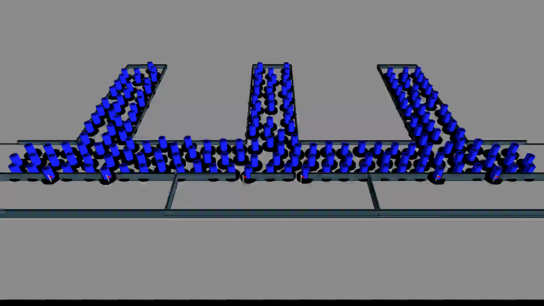
Researchers at the University of Sheffield have used FLAME GPU to power large-scale, real-time simulations of pedestrian movement, bringing agent-based modelling into practical railway applications. Through the RateSetter project, FLAME GPU was applied to the Passenger Train Interface (PTI) to model boarding and alighting flows, testing how rolling stock characteristics such as door width and carriage layout affect passenger movement. The tool was developed for the Rail Safety and Standards Board (RSSB) and Merseyrail, who sought to validate the model and gain practical insights ahead of a new fleet introduction.
When COVID-19 disrupted normal operations, the project pivoted to simulate the impact of social distancing on station passenger flows. Using FLAME GPU, the team rapidly modelled multiple scenarios, showing how reduced proximity slowed passenger movements and identifying situations likely to cause delays. These insights were integrated with a network-level model developed in collaboration with Risk Solutions, enabling RSSB and Train Operating Companies to anticipate crowding effects across the network before restrictions were lifted.
FLAME GPU was also used to simulate highly congested stations, including Peckham Rye, where old Victorian infrastructure causes significant crowding. The validated simulations allowed the team to test proposed platform redesigns, assess their likely effectiveness, and provide evidence-based recommendations to station managers.
The combination of FLAME GPU’s speed, scale, and realism allowed the team to simulate tens of thousands of passengers in real time, providing actionable data for infrastructure planning and operational decision-making during a period of great uncertainty. This work highlighted the software’s unique capability to translate high-performance computing into practical solutions that improve safety, efficiency, and passenger experience in real-world settings.
Testimonial
In 2018, Sheffield applied their Agent-Based Modelling approach, FLAME, to a railway application within the RSSB’s research call on Better, Safer, Faster Boarding and Alighting. This call focused on reducing risk and improving design at the Passenger-Train Interface. Sheffield modelled a number of rolling stock characteristics such as door width and internal carriage layout to improve boarding and alighting flow. RSSB and the rail industry were impressed by the tool and its capability and sought to apply it to a new rolling stock introduction, using Merseyrail as the example. This application aimed to validate the model and provide practical industry insight to Merseyrail as they prepared to introduce their new fleet of trains. Disruption due to the arrival of COVID-19 meant this industry deployment had to be put on hold. RSSB proposed a pivot to the project and asked Sheffield if they could apply the model to simulate the impact of the newly introduced social distancing on railway station passenger flows. The team worked hard and at a fast pace to provide the rail industry with early insight, particularly highlighting how social distancing would slow passenger flows as if in a crowding scenario. With these insights, RSSB was able to inform Network Rail and Train Operating Companies what to expect as passenger numbers increased.
The provision of this early insight prompted more requests from the rail industry for modelling scenarios. Sheffield continued to work with RSSB but also collaborated with Risk Solutions, a private company that had developed a network modelling tool. Working together, the trio of Sheffield, RSSB, and Risk Solutions integrated social distancing elements into a network model to simulate expected changes to boarding and alighting times. The RateSetter simulations using the FLAME system were able to determine the increased time required for passengers to board and alight in a vast number of scenarios. This information was integrated into a network model of the railway to highlight how the increase in time would compound across the network. The results of this were presented to the industry in good time, before social distancing restrictions were lifted, and enabled the rail industry to understand the risks and scenarios ahead of time. The modelling confirmed that in general situations the impact would be minimal; however, the team was able to show that when the wrong circumstances were set, the impact would be more pronounced and could cause delays. The key points of these delay scenarios were highlighted to the industry, helping them to appraise their routes and monitor for precursors.
This key work was able to deliver timely insight at a time of great uncertainty. The rail industry was very grateful for the insight and support. - Robert Staunton, Head of Research Implementation, RSSB
More Information
- RateSetter+: the impact of social distancing on network performance (RSSB COF-G22-01 Report - requires free signup)
- RateSetter: Improving passenger boarding rate and reducing risk at the PTI (RSSB COF-PTI-04 Report - requires free signup)
- RateSetter+: COVID-19 application (RSSB COF-G22-02 Report - requires free signup)